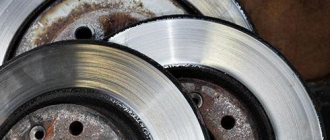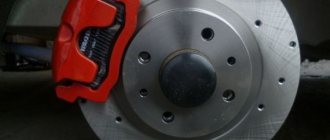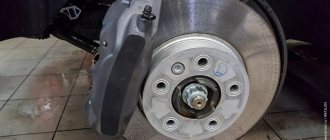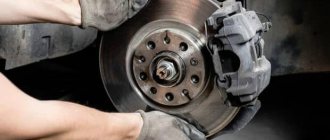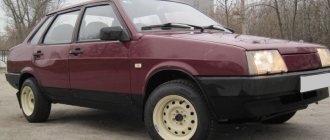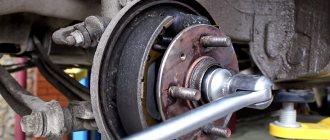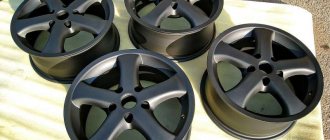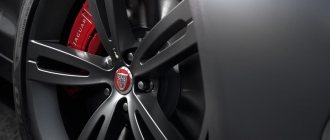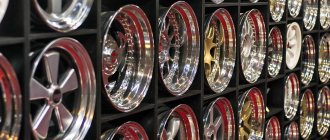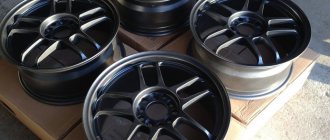The wheel rim is one of the most important parts that connects the car to the road through the tire. When replacing tires or buying new wheels, it often becomes necessary to find out the wheel parameters. Deciphering the markings of disks and other symbols on them will help you understand all the parameters and characteristics of your wheels.
Most characteristics of wheel rims affect driving safety and the duration of trouble-free operation of the suspension. When choosing wheels, you need to find out which models with what characteristics are allowed for use on your car. Only if all requirements are met can they be installed on the machine.
The ability to read wheel markings helps you accurately select the right wheels for your car. It is only important to correctly recognize the symbols printed on the disk so as not to make a mistake with their correct decoding.
Any wheel rim is an important part of the car, connecting it to the road surface through the tire. If the latter wears out, it becomes necessary to purchase new tires, and for this you should know the basic parameters of the disk itself, because this information is not limited only to the number of bolt holes and the diameter of the rim, which are what car enthusiasts most often pay attention to. At the same time, most of the parameters that are not taken into account are very significant for driving safety, as well as the safety of the suspension. Therefore, next we will try to understand in more detail the key characteristics of rims.
UGI2 UGIA Product Images
A car needs a propulsion device - a device that provides contact with the road and transmits forces and moments that set the car in motion. In other words, four wheels, each of which consists of a tire, rim, connecting element (disc) and hub. What is encrypted in the wheel markings? To read the “secret script”, use our hint.
The code by which you can select a wheel for a specific car is deciphered as follows:
Disc markings, symbols, terms on discs, designations
27/07/2009
Discs Marking
To choose wheels for your car, it is not enough to know the required diameter and the number of bolts for fastening. The disk must meet a number of parameters. The full disk size looks like this: 6.5×16 5/100 ET48 d56.1 . The ability to decipher symbols on disks will help you avoid mistakes when purchasing and disappointments when installing them on a car.
So:
6.5 - rim width value . Indicated in inches. If you want to know the size in millimeters, then 6.5 must be multiplied by 2.54 (1 inch).
j (can be replaced by “ H2 ”) - for ordinary consumers these values are not important, since they are service designations for manufacturers and sellers.
J is a value that encodes data on the design features of the edges of the rim flanges, such as their angles of inclination, radius/radii of curvature, etc.
H2 (short for Hump) - the presence of this designation indicates that there are annular projections (humps) on the rim flanges that keep the tubeless tire from sliding off the rim. The letter designation H means single (simple) hump. H2 - stands for double hump. There is also a Flat Hump - FH , Combi Hump - CH , Asymmetric Hump - AH . If there is an x sign between the designations of the width of the disk and its mounting diameter (as in this case), this means that the disk rim is one-piece, without humps.
5/100 - indicates the PCD value of the wheel (Pitch Circle Diameter). The number “5” is the number of fastening holes for nuts (bolts) on the disk, and in millimeters “100” is the diameter along which the fastening holes are located. If necessary, and there are no special instruments at hand, measurements can be taken with a regular stationery ruler.
IMPORTANT: The wheel mounting holes can be located on different diameters, which have a very tight tolerance relative to the central hole.
Warning! The mounting holes may have a small plus tolerance in diameter, which visually makes it difficult to accurately determine the PCD if it differs from the standard one by only 2 millimeters. For example, a wheel with a PCD value of 4/98 is often installed on a hub with a PCD value of 4/100. IS IT DANGEROUS!!! Only one nut (bolt) will be fully tightened. The mounting holes of the remaining 3 nuts will “lead”, as a result they will be undertightened or tightened skewed. As a result, the wheel will not be completely seated on the hub. When driving it will “beat”, there is a high risk that the nuts will gradually unscrew by themselves.
d - (example: d 66.6) - in millimeters indicates the diameter of the hub , or the value of the diameter of the central hole of the wheel. It is important that this parameter exactly matches the diameter of the vehicle hub mounting cylinder. Matching the sizes will ensure preliminary centering on the wheel hub, which will facilitate installation of the bolts.
ET - letter designation of disk offset , i.e. the distance in millimeters from the mating plane of the wheel disk installed on the car hub, and the conventional plane that runs in the middle of the wheel rim.
ET “positive” - the mating plane does not protrude beyond the conventional boundary.
ET “negative” - the mating plane is behind the imaginary plane.
In some countries, there is another designation for ET - OFFSET or DEPORT.
Examples of departure designations:
ET 46 - positive offset, 46 millimeters.
ET-20 - negative offset, 20 millimeters.
ET 0—zero offset.
Warning! It is dangerous to install wheels on a car whose disc offset differs from the standard one recommended by the car manufacturer. In an effort to give the car a sporty look, some car owners install wheels with a reduced offset. The car becomes a little more stable on the track, because... the wheel track becomes wider. And at the same time, the load on the car’s suspension and wheel bearings increases. And vice versa, it is impossible to increase the wheel offset - its wheel rim will rest against the brake disc. All this can lead not only to car breakdown, but also to an emergency on the road.
The wheel may also have the following symbols:
— Date of manufacture — (example: 0309) — means that the release date of the disc is the third week of 2009.
- ISO, SAE, TUV - the mark that is given by the regulatory body. This marking is confirmation that the wheel complies with international standards/rules.
— MAX LOAD 2000LB is the most commonly used value for the maximum wheel load capacity (in pounds or kilograms). In this example, the maximum permissible load limit is 2000 pounds, i.e. 908 kilograms. — PCD 4/100 — parameters of connecting dimensions; — MAX PSI50 COLD — maximum air pressure in the tire. In this example, no more than 50 pounds per square inch (3.5 kgf/sq.cm). “COLD” - translated as “cold” - a reminder that pressure measurements must be taken in a cold tire.
Recommendation from specialists at the online wheel store Kolesa Darom
Even if you feel that the technical terms are more or less clear to you, it is still better to select disks by consulting with a specialist directly at the time of purchase. This, at a minimum, saves money and time. And, as a maximum, it will save you from mistakes and, as a result, dangerous situations on the road.
Share
Vilet
Most tire centers and online stores sell exclusively Chinese wheels of the brands Replica, Nitro, etc. Do they meet safety standards?
As a rule, wheels presented in serious stores undergo mandatory certification and are approved for use. Don’t be shy, ask merchants for certificates for their goods.
What is the friction index?
The friction index is an important indicator when choosing brake pads. If the coefficient is lower than the minimum required by the automaker, the part will wear out more often, and therefore require replacement more often. Brake pads that are too hard actively wear down the brake disc and, as a result, cause unpleasant vibration when braking.
What should the friction index be?
The friction index value depends on the composition of the friction mixture of the pad. The more abrasive, the harder the pad and the stronger its impact on the brake disc; The less abrasive, the softer the pad, and the faster its wear. The friction mixture of brake pads can include up to 20 elements, which differ in the composition of the pad depending on the manufacturer. Depending on the proportions of the main elements, the pads are divided into several types:
- semi-metallic (Semi-metallic) - the friction mixture of this type of pads contains up to 65% iron or copper powder bound by graphite particles into a dense coating. The peculiarity of this type of pads is that they maintain a stable friction index under the influence of high temperatures; they are durable and suitable for high-speed driving.
- Low-metal pads consist of a 30% metal mixture and the rest a combination of organic materials. They are distinguished by high stability and excellent braking characteristics, but are quite noisy and noticeably dusty.
- ceramic (also organic) (Ceramic/Organic) - the most common for installation in standard cars. The friction mixture of such pads is dominated by organic components, mainly graphite, which makes the color of the part bright black. To strengthen the pad, bronze or Kevlar is also added to its composition. Organic pads are great for daily city driving; they are low noise and wear-resistant, but are susceptible to overheating and harsh/active braking.
The coefficient of friction "µ" for a running pad is not constant and tends to change depending on driving habits, track conditions, age of the part and weather conditions, so most brake parts manufacturers go to great lengths to ensure their brake pads are as stable as possible. Good city pads should have a constant µ and work in different temperatures without the need for pre-warming.
Friction coefficient identifiers were developed by the American organization Society of Automotive Engineers, which divided the pads by letter designations. Below we provide a standard table of coefficients:
| C | up to 0.15 |
| D | from 0.15 to 0.25 |
| E | from 0.25 to 0.35 |
| F | from 0.35 to 0.45 |
| G | from 0.45 to 0.55 |
| H | from 0.55 to 0.8 |
| Z | indefined |
If you look at branded certified brake pads, you will notice that the marking consists of two letters. The first denotes the average coefficient of friction, which was measured at temperatures of 90°C, 122°C, 149°C, 205°C. The second letter means the coefficient, which was calculated on an overheated block in 10 temperature values. Most often, there are designations with two identical letters, but there are options where the second letter is older than the previous one, for example, “FG” - this designation is typical for sports-type brake pads that require preheating. If the first letter is older, then you have a low-temperature brake pad made on the basis of an organic friction mixture. For city driving, it is better to take pads with a friction index of “HH” or “FF”.
| Manufacturer | Detail number | Part name | Applicability* |
| BREMBO | P56046 | Brake pads Brembo, INFINITI, NISSAN, RENAULT, SUZUKI | INFINITI FX, G, M35, M45, NISSAN Altima, Cube, Dualis, Elgrand, Maxima, Murano, Qashquai, Serena, Teana, Tiida, Versa, X-Trail, RENAULT Koleos, SUZUKI Landy |
| BREMBO | P24061 | Brake pads Brembo, FORD, MAZDA, VOLVO | FORD C-Max, Ecosport, Escape, Focus, Grand, Kuga, MAZDA 3, 5, Axela, Premacy, VOLVO C30, C70, S40, V40, V50 |
| BREMBO | P85072 | Brake pads Brembo, AUDI, SEAT, SKODA, VW | AUDI A2, A3, SEAT Altea, Ibiza, Leon, Toledo, SKODA Citigo, Fabia, Laura, Octavia, Praktik, Roomster, Yeti, VW Beetle, Bora, Caddy, Derby, Golf, Jetta, New, Novo, Polo, Rabbit, Up, Vento |
| BREMBO | P78013 | Brembo brake pads, front, SUBARU | SUBARU BRZ, Forester, Impreza, Lagcy, Liberty, Outback |
| BREMBO | P83066 | Brake pads Brembo, LEXUS, MITSUBISHI, TOYOTA | LEXUS GX, MITSUBISHI Montero, Pajero, Shogun, TOYOTA 4, FJ, Fortuner, Hilux, Land, SW4, Tacoma, Tundra |
| BREMBO | P83024 | Brembo brake pads, front, LEXUS, MITSUBISHI, TOYOTA | LEXUS GX, MITSUBISHI Montero, Pajero, Shogun, TOYOTA Prado |
| KASHIYAMA | D6108 | Brake pads KASHIYAMA, front, MITSUBISHI | MITSUBISHI Lancer, Outlander |
| KASHIYAMA | D1261 | Brake pads KASHIYAMA, front, LADA, NISSAN, RENAULT, SUZUKI | LADA Largus without ABS, NISSAN Almera, RENAULT Duster, SUZUKI Swift III 05- |
| KASHIYAMA | D6124 | Brake pads KASHIYAMA, rear, MITSUBISHI | MITSUBISHI Lancer, Outlander |
| KASHIYAMA | D1244M | Brake pads KASHIYAMA, rear, NISSAN | NISSAN Murano, Qashquai, Tiida |
| KASHIYAMA | D6039M | Brake pads KASHIYAMA, front, MITSUBISHI | MITSUBISHI Outlander, Outlander XL, Space Wagon |
| KASHIYAMA | D1276 | Brake pads KASHIYAMA, front, NISSAN | NISSAN X-Trail, Qashquai |
| KASHIYAMA | D2268 | Brake pads KASHIYAMA, front, TOYOTA | TOYOTA RAV-4 06- |
| KASHIYAMA | D2270 | Brake pads KASHIYAMA, front, TOYOTA | TOYOTA Camry 06- |
| KASHIYAMA | D6128M | Brake pads KASHIYAMA, front, MITSUBISHI | MITSUBISHI L200 2.5DI-D 05- |
| NIBK | PN0537 | Brake pads NIBK, front, KIA | KIA RIO III 11-12- |
| NIBK | PN0538 | Brake pads NIBK, rear, HYUNDAI, KIA | HYUNDAI Solaris 10-, I30 11- 13-, I40 11-, KIA RIO 11- 12-, Ceed 12- 13-, Optima 2.0 12- |
| NIBK | PN3233 | Brake pads NIBK, CITROEN, MITSUBISHI, PEUGEOT | CITROEN C-Crosser, MITSUBISHI 3000, AirTrek, Aspire, Sedia, Challenger, Colt/Rodeo, Delica, Eclipse, Eterna, FTO, Galant, Grandis, GTO, G-Wagon, Lm Lancer, Legnum, Libero, Magna, Mighty, Montero , Nimbus, Outlander, Pajero, PHEV, Shogun, Sigma, Space, Strada, Triton, Verada, PEUGEOT 4007 |
| NIBK | PN1243 | Brake pads NIBK, rear, TOYOTA | TOYOTA 4runner 04-08, Hilux 02-05, Land Cruiser 90-04 |
| NIBK | PN0436 | Brake pads NIBK, rear, HYUNDAI | HYUNDAI Accent 1.4/1.6L 05-, Accent usa 1.4/1.6L 06-, i30 1.4/1.6/2 |
* Please check the applicability of parts specifically for your car with our managers by phone (calls within Russia are free).
Purpose and design of wheel rims
Car wheel design
Wheel rims, in addition to improving the appearance of the wheel, are also a necessary element for driving a car on the road. The tire itself is put on them directly. A disk with a tire on it is a car wheel mounted on a hub.
The tire is fixed on the rim by an annular ledge. The tire bead is located on a shelf that has three dimensions: standard, flat and widened. The tire is usually seated on the outer shelf. The shelf smoothly transitions into the side, which has a different profile shape.
The main purpose of the wheel rim is to ensure that the tire fits correctly and operates efficiently while driving. That is why the main requirements for a disk are strength and rigidity. Also, the disk must have a relatively small mass and geometric parameters specified by the manufacturer. This is due to the fact that wheels, as unsprung mass, influence the vehicle's driving dynamics and its handling.

